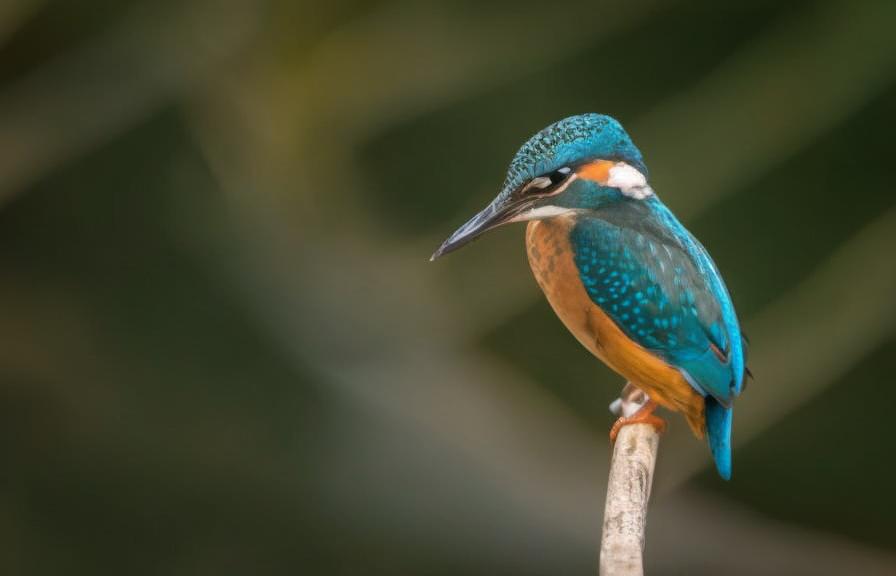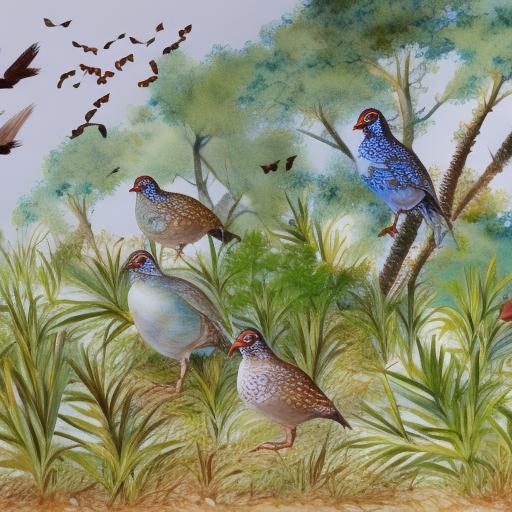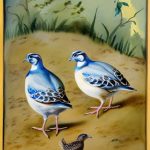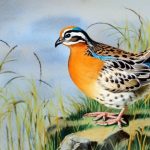Jungle Bush Quail, also known as Perdicula asiatica, are small, ground-dwelling birds that belong to the Phasianidae family. They are native to the Indian subcontinent and are found in various habitats such as grasslands, scrublands, and open forests. There are three recognized subspecies of Jungle Bush Quail, each with its own unique characteristics and distribution. These birds are known for their distinctive appearance and behavior, making them a fascinating subject for bird enthusiasts and researchers alike.
Jungle Bush Quail are known for their secretive nature and are often difficult to spot in the wild due to their small size and cryptic plumage. They are primarily ground-dwelling birds and are rarely seen in flight. Their small size and intricate patterns make them well-camouflaged in their natural habitat, allowing them to blend in seamlessly with their surroundings. Despite their elusive nature, Jungle Bush Quail are a popular subject for birdwatchers and photographers due to their unique beauty and behavior.
Key Takeaways
- Jungle bush quail are a group of small, ground-dwelling birds found in the jungles and forests of India.
- They are known for their distinctive plumage and secretive nature, making them a popular target for birdwatchers and wildlife enthusiasts.
- Jungle bush quail prefer dense undergrowth and thick vegetation, and are often found in the foothills of the Himalayas and the Western Ghats.
- Their diet consists of seeds, insects, and small invertebrates, and they are known to forage on the forest floor in small groups.
- Due to habitat loss and hunting, jungle bush quail are considered to be at risk and are listed as near threatened on the IUCN Red List.
Characteristics of Jungle Bush Quail
Jungle Bush Quail are small birds, measuring around 16-18 cm in length and weighing approximately 40-50 grams. They have a distinctive appearance, with a mottled brown and buff plumage that provides excellent camouflage in their natural habitat. Their plumage is marked with intricate patterns, including streaks and spots, which help them blend in with the leaf litter and undergrowth where they forage for food. Both males and females have similar plumage, although males may have slightly brighter colors during the breeding season.
These birds have a round body with a short tail and a small head. They have a distinctive white throat patch and a black stripe running from the eye to the nape of the neck. Their legs are short but sturdy, adapted for a life on the ground. Jungle Bush Quail have a distinctive call, which is a series of whistling notes that can be heard throughout their habitat. Overall, these birds have a charming and unique appearance that sets them apart from other quail species.
Habitat and Distribution of Jungle Bush Quail
Jungle Bush Quail are found in a variety of habitats across the Indian subcontinent, including grasslands, scrublands, open forests, and agricultural fields. They are primarily found in areas with dense undergrowth and thick vegetation, which provides them with cover and protection from predators. These birds are most commonly found in areas with tall grasses, shrubs, and bushes, where they can forage for seeds, insects, and small invertebrates.
The distribution of Jungle Bush Quail varies across their range, with different subspecies occupying different regions. The nominate subspecies, Perdicula asiatica asiatica, is found in central and northern India, while the southern subspecies, Perdicula asiatica bengalensis, is found in southern India and Sri Lanka. The third subspecies, Perdicula asiatica interposita, is found in the eastern part of the Indian subcontinent. Despite their specific distribution, Jungle Bush Quail are generally widespread within their range and can be found in suitable habitats throughout their distribution area.
Behavior and Diet of Jungle Bush Quail
Jungle Bush Quail are primarily ground-dwelling birds and are rarely seen in flight. They spend most of their time foraging for food on the forest floor, using their strong legs to scratch at the leaf litter and soil in search of seeds, grains, insects, and small invertebrates. These birds are known for their secretive nature and are often difficult to spot due to their cryptic plumage and elusive behavior. They are most active during the early morning and late afternoon when they can be heard calling to one another as they move through the undergrowth.
During the breeding season, male Jungle Bush Quail will perform elaborate courtship displays to attract females. These displays may include puffing up their feathers, bobbing their heads, and calling loudly to establish their territory and attract a mate. Once a pair has bonded, they will build a shallow nest on the ground hidden within dense vegetation. The female will lay a clutch of eggs, which she will incubate for around 18-20 days before they hatch. Both parents will care for the chicks until they are old enough to fend for themselves.
Conservation Status of Jungle Bush Quail
Jungle Bush Quail are currently listed as “Least Concern” on the IUCN Red List of Threatened Species due to their widespread distribution and relatively stable population. However, like many bird species, they face threats from habitat loss and degradation due to agricultural expansion, urbanization, and deforestation. Additionally, hunting and trapping for the pet trade pose additional threats to their populations in some areas.
Conservation efforts for Jungle Bush Quail focus on protecting their natural habitat through the establishment of protected areas and wildlife reserves. These efforts aim to conserve the diverse range of habitats that Jungle Bush Quail rely on for food, shelter, and breeding. Additionally, raising awareness about the importance of these birds and their role in the ecosystem is crucial for their long-term conservation.
Breeding and Reproduction of Jungle Bush Quail

Breeding season for Jungle Bush Quail typically occurs during the monsoon months when food availability is at its peak. Male quails will establish territories and perform elaborate courtship displays to attract females. Once a pair has bonded, they will build a shallow nest on the ground hidden within dense vegetation. The female will lay a clutch of 4-6 eggs, which she will incubate for around 18-20 days before they hatch.
Both parents will care for the chicks until they are old enough to fend for themselves. The chicks are precocial, meaning they are born with their eyes open and are able to leave the nest shortly after hatching. They will follow their parents as they forage for food and learn essential survival skills from them. Jungle Bush Quail reach sexual maturity at around 3-4 months of age and will begin breeding in their first year.
Keeping Jungle Bush Quail as Pets
Keeping Jungle Bush Quail as pets requires careful consideration of their specific needs and requirements. These birds require a spacious aviary with plenty of ground cover such as grasses, shrubs, and leaf litter to mimic their natural habitat. Providing hiding spots such as logs or dense vegetation is essential to help them feel secure in captivity.
Their diet should consist of a variety of seeds, grains, insects, and small invertebrates to ensure they receive all the necessary nutrients for optimal health. Fresh water should be available at all times for drinking and bathing. It’s important to provide enrichment such as perches, toys, and hiding places to keep them mentally stimulated.
When considering keeping Jungle Bush Quail as pets, it’s crucial to ensure that they are obtained from reputable sources to prevent contributing to illegal wildlife trade or unsustainable captive breeding practices. Additionally, it’s important to check local regulations regarding keeping quail as pets as some areas may have specific restrictions or requirements for keeping these birds in captivity.
In conclusion, Jungle Bush Quail are fascinating birds with unique characteristics and behaviors that make them an intriguing subject for bird enthusiasts and researchers alike. Their elusive nature and cryptic plumage add to their allure, making them a sought-after sighting for birdwatchers in their natural habitat. While they face threats from habitat loss and hunting, conservation efforts aim to protect these birds and their diverse habitats for future generations to appreciate and enjoy. For those interested in keeping Jungle Bush Quail as pets, it’s essential to provide them with a suitable environment that meets their specific needs while also ensuring ethical sourcing practices are followed.
If you’re interested in learning more about creating the ideal environment for jungle bush quail breeds, you may also want to explore an article on the best flooring options for chicken coops at Poultry Wizard. Understanding the importance of a suitable coop floor can provide valuable insights into maintaining a healthy and comfortable habitat for your quails.
FAQs
What are jungle bush quail breeds?
Jungle bush quail breeds are a type of quail that are found in the jungles and bushlands of India and Southeast Asia. They are known for their distinctive appearance and behavior.
What do jungle bush quail breeds look like?
Jungle bush quail breeds are small, ground-dwelling birds with mottled brown and black plumage. They have a distinctive crest on their head and are known for their secretive and elusive nature.
What is the habitat of jungle bush quail breeds?
Jungle bush quail breeds are typically found in dense undergrowth, thickets, and scrublands within the jungle and bushland habitats. They prefer areas with plenty of cover and are often difficult to spot due to their secretive nature.
What do jungle bush quail breeds eat?
Jungle bush quail breeds are omnivorous and feed on a variety of seeds, insects, and small invertebrates. They forage on the ground, using their strong legs and beak to search for food in the leaf litter and undergrowth.
Are jungle bush quail breeds endangered?
Jungle bush quail breeds are not currently considered to be endangered. However, their populations may be at risk due to habitat loss and fragmentation, as well as hunting and trapping for the pet trade. Conservation efforts are important to ensure the long-term survival of these birds.
Meet Walter, the feathered-friend fanatic of Florida! Nestled in the sunshine state, Walter struts through life with his feathered companions, clucking his way to happiness. With a coop that’s fancier than a five-star hotel, he’s the Don Juan of the chicken world. When he’s not teaching his hens to do the cha-cha, you’ll find him in a heated debate with his prized rooster, Sir Clucks-a-Lot. Walter’s poultry passion is no yolk; he’s the sunny-side-up guy you never knew you needed in your flock of friends!







